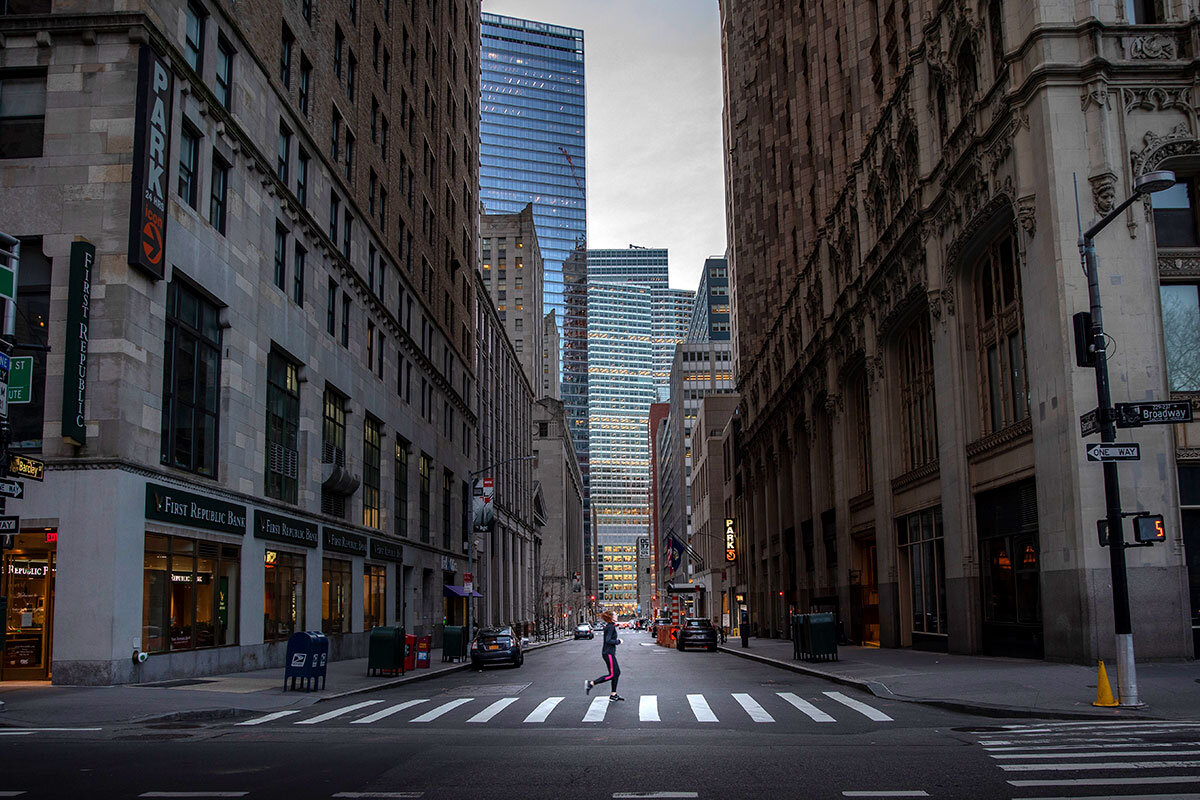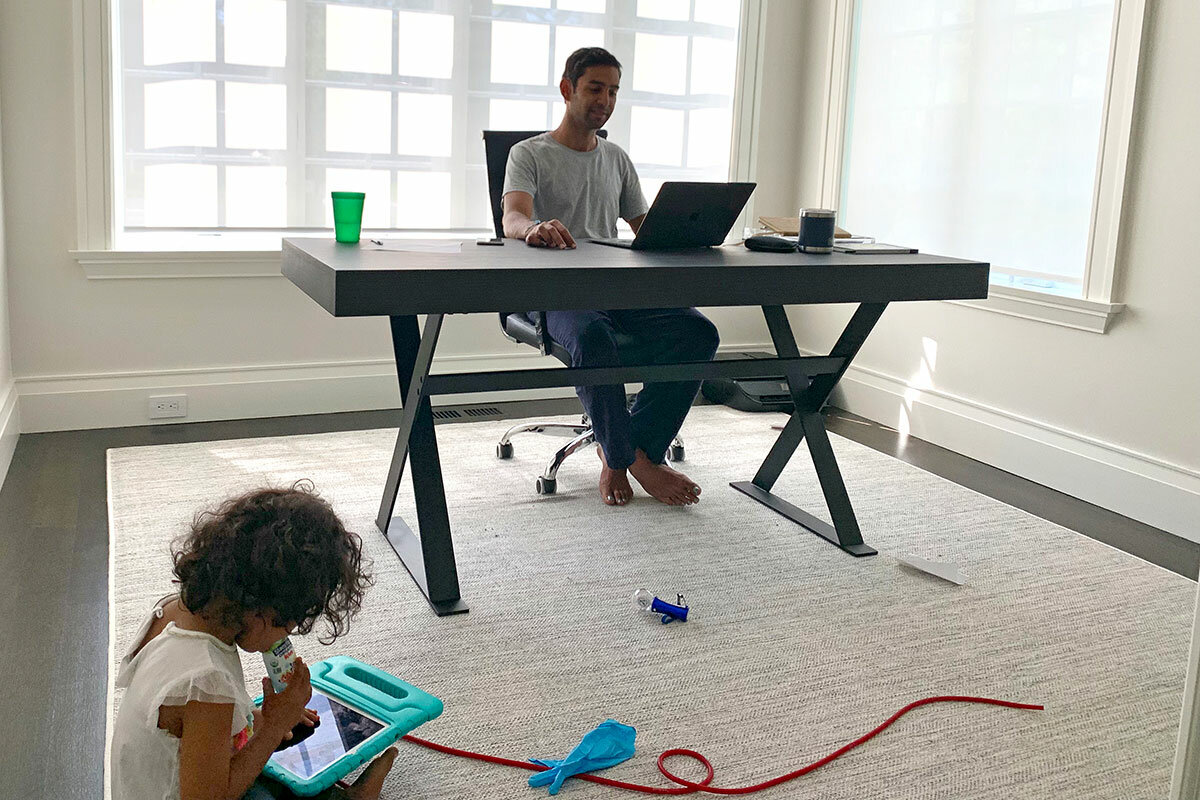What will happen to Big Apple’s core? Clues from reopening.
Loading...
| New York
Neal Taparia has found he kind of likes running his Manhattan-based tech company from his home.
When the pandemic began to ravage the city last March, he and thousands of other “nonessential” office workers were suddenly forced to leave their Manhattan conference rooms and cubicles and work remotely, via Zoom and Slack.��
The virus put a sudden halt to what could be called the city’s classic professional lifestyle: the crowded commutes downtown and back; the long, meeting-packed days at the office with meals at your desk; the hard-charging ambition of a city that, as the saying goes, never sleeps.
Why We Wrote This
How will the pandemic change working life in New York? Firms and residents are both leaving. But the hollowing out of the Big Apple has been predicted before – including after the 1918 pandemic and the terrorist attacks on 9/11. Part 1 of a series.
For Mr. Taparia and many of his employees, the jarring transition, both emotional and professional, was far from seamless as the built-in boundaries between home and work life dissolved. “But once we started establishing sound practices for working from home, it became pretty clear that our employees, and even myself, we loved the flexibility,” says Mr. Taparia, a tech entrepreneur who last year co-founded SOTA Partners, which invests in forward-looking companies, including those rethinking the future of the workplace.
“And because everyone was commuting to the office, they all said, this is just great because they have so much time back in their day,” continues Mr. Taparia, who now runs the SOTA venture . “They also touted other things like, this is eco-friendly, we’re not spending money on gas or train passes, we’re saving money, and things like that.”
“So soon it became pretty clear, why should we even bother with paying all that rent for a midtown office when we’ve been pretty effective at home?” he says.
A large-scale experiment
It’s been about five months since New York became one of the first regions in the country to shut down its nonessential workplaces and businesses, transforming its streetscapes of glass towers and 19th-century office lofts into relatively deserted ghost towns.
Many white-collar workers have been returning to the office since the end of June, following of the city’s reopening plans, which permitted offices to operate at half capacity. But about 90% of Manhattan’s office workforce remained working from home in mid-July, .��
While it’s still relatively early in New York’s cautious reopening process, the wide-scale experiment in working from home has proved to work on a number of levels for white-collar employers and employees – perhaps signaling dramatic changes to the classic culture of urban-centered professional lifestyles as more and more companies plan to allow at least some of their employees to work from home permanently.
“The expense to the culture of downtown business areas is a significant issue here,” says Deanna Geddes, of human resource management in the Fox School of Business at Temple University in Philadelphia. “And there can be a real trickle-down effect if office workers stay home after COVID, because while so-called knowledge workers can work at home, all those who are in the service industries and who expect a large crowd – either in transportation, in retail, or in food – their livelihood is tremendously affected when there is no longer that large group of people coming to their area of business.”
“And, yeah, I do think it’s not unreasonable to consider that the economies of American downtowns may change,” continues Professor Geddes.
The end of the office?
Manhattan financial firms that most of their employees will continue to work from home through the end of the year, and perhaps longer. “We’ve proven we can operate with no footprint,” Morgan Stanley CEO James Gorman . “That tells you an enormous amount about where people need to be physically.”
Major technology firms have gone even further. Google announced across the country will continue to work from home until next July. Facebook employees won’t return to the office at least until next year, and CEO Mark Zuckerberg said the company expects will work from home 10 years from now.��Twitter CEO Jack Dorsey they could work from home indefinitely, even after the crisis ends.��
The demise of New York City has often been greatly exaggerated, however, and many in the past wondered whether the city could bounce back after the 1918 flu pandemic, the city’s near bankruptcy in the 1970s, and the terrorist attacks on 9/11. It always did.
Facebook nevertheless for Manhattan’s iconic, 730,000-square-foot former post office across from Madison Square Garden, part of 2.2 million square feet of office space the company has taken in the city over the past year.
Still, industry experts say New York City may see up to one-third of its 240,000 small businesses close for good, especially those that have relied on Manhattan’s cadres of office commuters, by the Partnership for New York City. Such businesses have lost about 520,000 jobs as the city’s unemployment rate topped 20% in June.
“My existential question is, how much of the things that we’ve seen in response to COVID are temporary and an immediate reaction to people navigating the uncertainty of this time, and how much of them stand to be permanent?” says Malcom Glenn, in the Future of Property Rights program at New America, a think tank in Washington.
“I’ve always been really bullish about the future of cities,” says Mr. Glenn. “Notwithstanding the social benefits and the fact that you have access to arts and culture, other people with more diverse perspectives of thought and cultural backgrounds, from the perspective of the environmental imperative to have more people sharing resources, I think cities remain more environmentally sustainable.”
“Offices will continue to exist, I think. The human spirit prizes in-person engagement,” he says.
Fleeing to the burbs
Many well-off urban professionals who had been living in American cities have been heading to the suburbs, however, prioritizing more space, private backyards, and . Driven by the realization that their work lives, leisure time, and schooling for their children might remain the new norm at home heading into the near future, they have fueled a in existing-home sales across the United States.
Indeed, New York City’s sky-high apartment rental market , even as the National Association of Realtors reports that home sales nationwide climbed .��
“A lot of emotions are tied to COVID,” says Professor Geddes, who studies the roles emotions play in the workplace. “For those who could work remotely, some of those were relief that you can be at home and safe, be relatively secure with your job and your paycheck, and find an increased closeness and patience and love with your family – even though we know that being together for many, many hours can be a mixed blessing.”
It’s been an adjustment for Mr. Taparia, who lives in Scarsdale, a suburb in Westchester County. He arrived in New York fresh out of college almost 15 years ago to work on Wall Street before starting his first company, and he says he misses the intangibles within the rhythms of working in the city, including the walk-and-talk meetings in Bryant Park, lunches with friends and fellow entrepreneurs, and discovering a new restaurant in the evenings after work.��
”A lot of our creative thoughts and best decisions have happened from those conversations,” he says.
But the advantages of working from home – the reduced costs, the flexibility and extra hours in the day without a daily commute, and the productivity of his employees – made the permanent move make sense.��
For him, the mixed blessing has been all the extra time he can now spend with his wife, Sureena; 6-year-old son, Kavin; and 4-year-old daughter, Navya. “They’ve gotten so used to me being at home all the time, and they sometimes think that I’m choosing not to spend my time with them when I need to focus in the office,” he says. “They always say, ‘Dad, why are you always working?’”
But he has eased into a new rhythm in his professional life, helping to develop concrete daily protocols for his remote staff, who’ve had to find a balance between their home and professional lives.��
“The first thing we did is, we started creating these flexibility windows for our team,” he says. While he’s been strict with his family about his work time in his home office, there are no staff meetings scheduled from 9 to 10 a.m., 12 to 1 p.m., or 4 to 5 in the early evening. “That has allowed us to support our team so they can take care of their family life and do what they want.”
They’ve also emphasized creating a more goal-oriented culture rooted in mutual accountability, he says. Employees send a 100-word email to the entire team each day, outlining their daily and weekly goals, the daily challenges they’re facing, and what they plan to do the following day.
“It’s worked well because, as long as they set and meet their goals, I don’t really care what hours my employees work,” Mr. Taparia says. “I’m OK with that because I know they have other things to do, kids to juggle, and, God knows, deal with the screaming in the background that happens at my house.”
“But nothing beats just connecting with someone in person,” he continues. “So our goal is, when things are better and we are comfortable with our team traveling again, we can get together maybe once a month, or once a quarter, in Manhattan at a place like Convene,” a business that rents out conference rooms.
“We can spend our money on that, and from time to time gather the team together to have brainstorming sessions, or just have some face time together, or do an office activity,” he says. “But otherwise, being at home, that’s how we see work life moving forward.”
Editor’s note: As a public service, we have removed our paywall for all pandemic-related stories.






